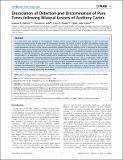| dc.contributor.author | Braida, Louis D. | |
| dc.contributor.author | Dykstra, Andrew Richard | |
| dc.contributor.author | Koh, Christine K. | |
| dc.contributor.author | Tramo, Mark Jude | |
| dc.date.accessioned | 2012-11-14T15:24:07Z | |
| dc.date.available | 2012-11-14T15:24:07Z | |
| dc.date.issued | 2012-09 | |
| dc.date.submitted | 2011-11 | |
| dc.identifier.issn | 1932-6203 | |
| dc.identifier.uri | http://hdl.handle.net/1721.1/74636 | |
| dc.description.abstract | It is well known that damage to the peripheral auditory system causes deficits in tone detection as well as pitch and loudness perception across a wide range of frequencies. However, the extent to which to which the auditory cortex plays a critical role in these basic aspects of spectral processing, especially with regard to speech, music, and environmental sound perception, remains unclear. Recent experiments indicate that primary auditory cortex is necessary for the normally-high perceptual acuity exhibited by humans in pure-tone frequency discrimination. The present study assessed whether the auditory cortex plays a similar role in the intensity domain and contrasted its contribution to sensory versus discriminative aspects of intensity processing. We measured intensity thresholds for pure-tone detection and pure-tone loudness discrimination in a population of healthy adults and a middle-aged man with complete or near-complete lesions of the auditory cortex bilaterally. Detection thresholds in his left and right ears were 16 and 7 dB HL, respectively, within clinically-defined normal limits. In contrast, the intensity threshold for monaural loudness discrimination at 1 kHz was 6.5±2.1 dB in the left ear and 6.5±1.9 dB in the right ear at 40 dB sensation level, well above the means of the control population (left ear: 1.6±0.22 dB; right ear: 1.7±0.19 dB). The results indicate that auditory cortex lowers just-noticeable differences for loudness discrimination by approximately 5 dB but is not necessary for tone detection in quiet. Previous human and Old-world monkey experiments employing lesion-effect, neurophysiology, and neuroimaging methods to investigate the role of auditory cortex in intensity processing are reviewed. | en_US |
| dc.description.sponsorship | United States. National Institutes of Health (DC03328) | en_US |
| dc.description.sponsorship | United States. National Institutes of Health (DC006353) | en_US |
| dc.description.sponsorship | United States. National Institutes of Health (DC00117) | en_US |
| dc.description.sponsorship | United States. National Institutes of Health (T32-DC00038) | en_US |
| dc.language.iso | en_US | |
| dc.publisher | Public Library of Science | en_US |
| dc.relation.isversionof | http://dx.doi.org/10.1371/journal.pone.0044602 | en_US |
| dc.rights | Creative Commons Attribution | en_US |
| dc.rights.uri | http://creativecommons.org/licenses/by/2.5/ | en_US |
| dc.source | PLoS | en_US |
| dc.title | Dissociation of Detection and Discrimination of Pure Tones following Bilateral Lesions of Auditory Cortex | en_US |
| dc.type | Article | en_US |
| dc.identifier.citation | Dykstra, Andrew Richard et al. “Dissociation of Detection and Discrimination of Pure Tones Following Bilateral Lesions of Auditory Cortex.” Ed. Jun Yan. PLoS ONE 7.9 (2012). | en_US |
| dc.contributor.department | Harvard University--MIT Division of Health Sciences and Technology | en_US |
| dc.contributor.department | Harvard University--MIT Division of Health Sciences and Technology | en_US |
| dc.contributor.department | Massachusetts Institute of Technology. Department of Electrical Engineering and Computer Science | en_US |
| dc.contributor.department | Massachusetts Institute of Technology. Research Laboratory of Electronics | en_US |
| dc.contributor.mitauthor | Braida, Louis D. | |
| dc.contributor.mitauthor | Dykstra, Andrew Richard | |
| dc.relation.journal | PLoS ONE | en_US |
| dc.eprint.version | Final published version | en_US |
| dc.type.uri | http://purl.org/eprint/type/JournalArticle | en_US |
| eprint.status | http://purl.org/eprint/status/PeerReviewed | en_US |
| dspace.orderedauthors | Dykstra, Andrew R.; Koh, Christine K.; Braida, Louis D.; Tramo, Mark Jude | en |
| dc.identifier.orcid | https://orcid.org/0000-0003-2538-9991 | |
| dspace.mitauthor.error | true | |
| mit.license | PUBLISHER_CC | en_US |
| mit.metadata.status | Complete | |
